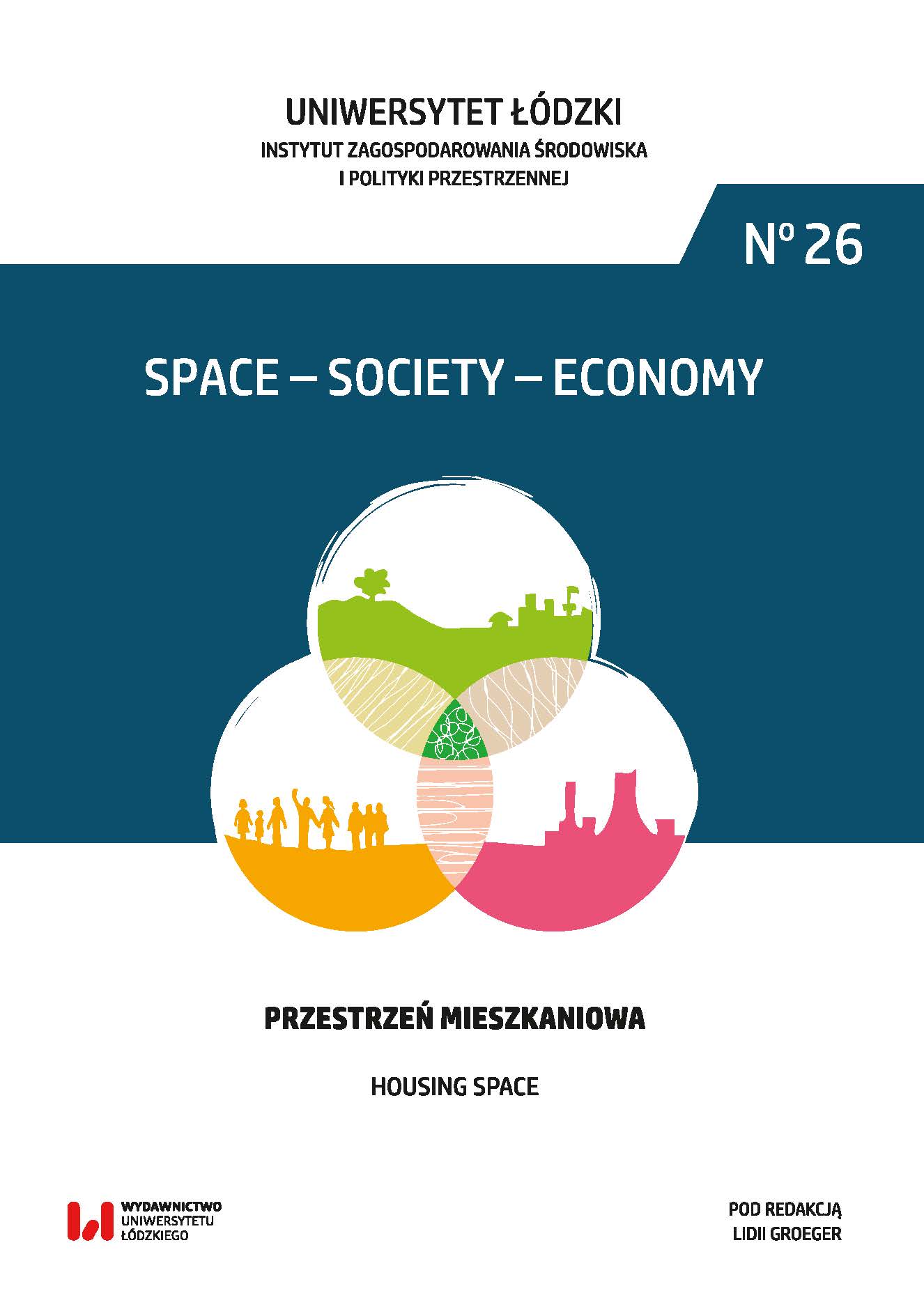Idea of a dwelling house – spatial and temporal dimension
DOI:
https://doi.org/10.18778/1733-3180.26.02Keywords:
Residential house, spatial dimensions of the house, housing, residential architecture, history of construction techniques, history of architectureAbstract
Spatial dimension of dwelling house, and the same his shape and the size, were subject to dynamic changes in the time under the influence of the development of techniques and building technologies and individual and social evolution of needs. A transition from the primitive refuge in prehistorically times to modern luxury villa and apartments attests to the huge scale of transformations of the residential building. In our times a dream of writers and researchers about the glassy houses was fulfilled. In individual historical ages different standards of houses being subject to a spatial diffusion rose from parent regions at first to neighboring and then more distant. Some elements of architecture and functions of dwelling houses originating from earlier periods were inherited through newer buildings, in addition at the same time a development of building techniques took place and all at the same time housing architecture evolved. In every historical period houses of the different size and distinctive features were erected, but a symbol of the present became residential high-rises. In determined historical periods it is possible to find examples of traditional houses and buildings which in contemporary conditions it is possible to recognize from modern. Starting from the 19th century completely new structures, techniques and building materials were entered into construction of dwelling houses. All at the same time internal functional divisions of flats and their comfort were made rich. In the period of the Modern Style exceptionally original, fabulously colorful, about diversified shapes with flower and plant details built dwelling houses Antonio Gaudi. For their construction he applied stones and brick, with the addition of ceramics. A functional concept of the altitude housing industry of Ch.E. Le Corbusier and the organic concept F.L. Wright of detached houses united with natural surroundings exerted the peculiarly strong influence on modern housing architecture. In contemporary times of the on the basis of different theories of architecture, referring to the concept balanced development, in shaping the housing environment more and more implemented successively innovative ideas of the ecological, energy-efficient, passive and “intelligent” house play the greater role.
Downloads
References
Bartnicka M., 2013, Zapomniane wzorce, wypaczone idee. Nowatorstwo przełomu lat 20. i 30. XX w. – co po nim zostało, „Architectus”, 1 (33): 37–52.
Google Scholar
Benjamin D.N., Stea D., Saile D. (red.), 1995, The Home: Words, Interpretation, Meaning and Environments, Avebury, London.
Google Scholar
Blunt A., Dowling R., 2006, Home, Rutledge, London.
Google Scholar
DOI: https://doi.org/10.4324/9780203401354
Braun H., 1969, Old English Houses, Faber and Faber Ltd., London.
Google Scholar
Czarnecki M., Rytel G., 2013, Zagadnienia ekologii i energooszczędności w architekturze – współczesne tendencje w projektowaniu domów jednorodzinnych, „Architecturae et Artibus”, 4: 11–20.
Google Scholar
Dąbrowska-Milewska G., 2018, Dom prywatny jako architektura oparta na ideach, Biblioteka Cyfrowa PK, Kraków.
Google Scholar
Dechnik M., Moskwa S., 2017, Smart House – inteligentny budynek – idea przyszłości, „Przegląd Elektrotechniczny”, 93 (9): 1–10.
Google Scholar
DOI: https://doi.org/10.15199/48.2017.09.01
Dzieciuchowicz J., Groeger L., 2016, Nowa przestrzeń mieszkaniowa. Lofty i rezydencje w Łodzi, Wydawnictwo Uniwersytetu Łódzkiego, Łódź.
Google Scholar
Esthope H., 2004, A place called home, „Housing, Theory and Society”, 21 (3): 128–138.
Google Scholar
DOI: https://doi.org/10.1080/14036090410021360
Feist W., 2006, Podstawy budownictwa pasywnego, Polski Instytut Budownictwa Pasywnego, Gdańsk.
Google Scholar
Flint A., 2017, Le Corbusier. Architekt jutra, Grupa Wydawnicza Foksal, Warszawa.
Google Scholar
Górecka M., 2009, Standardy budynków niskoenergochłonnych w aspekcie kształtowania architektury, „Przegląd Naukowy. Inżynieria i Kształtowanie Środowiska”, 18 (3): 35–46.
Google Scholar
Hammond N.G.L., 1973, Dzieje Grecji, Państwowy Instytut Wydawniczy, Warszawa.
Google Scholar
Hareven T., 1993, The home and the family in historical perspective, [w:] Mack A. (red.), Home: A Place in the World, New York University Press.
Google Scholar
Heuggon J., 1973, Rzym i świat śródziemnomorski, Państwowy Instytut Wydawniczy, Warszawa.
Google Scholar
Jones D. (red.), 2015, Historia architektury, Wydawnictwo Arkady, Warszawa.
Google Scholar
Jurewicz O., Winniczuk L., 1973, Starożytni Grecy i Rzymianie w życiu prywatnym i państwowym, Państwowe Wydawnictwo Naukowe, Warszawa.
Google Scholar
Kalopissis T., 1995, Domy świata, Videograf, Katowice.
Google Scholar
Kemp B.J., 2009, Starożytny Egipt. Anatomia cywilizacji, Państwowy Instytut Wydawniczy, Warszawa.
Google Scholar
Massey D., 1992, A place called home?, „New Formations”, 17: 3–15.
Google Scholar
May I., Cloke P., 2006, Housing and housing market, [w:] Warf B. (red.), Encyclopedia of Human Geography, Sage, London–New Delhi.
Google Scholar
Olmstead A.T., 1974, Dzieje imperium perskiego, Państwowy Instytut Wydawniczy, Warszawa.
Google Scholar
Ostrowski W., 2001, Wprowadzenie do historii budowy miast. Ludzie i środowisko, Oficyna Wydawnicza Politechniki Warszawskiej, Warszawa.
Google Scholar
Peil T., 2009, Home, International Encyclopedia of Human Geography, Eds. Rob Kitchin, Neigel Thrift, Elsevier Ltd., Amsterdam–Oxford.
Google Scholar
DOI: https://doi.org/10.1016/B978-008044910-4.00957-3
Rybczyński W., 2015, Dom: krótka historia idei, Wydawnictwo Karakter.
Google Scholar
Saggs H.W.F., 1972, Wielkość i upadek Babilonii, Państwowy Instytut Wydawniczy, Warszawa.
Google Scholar
Samsonowicz H., 2017, Życie miasta średniowiecznego, Wydawnictwo Poznańskie, Poznań.
Google Scholar
Somerville P., 1992, Homelessness and the meaning of home: Rooflessness or rootlessness, „International Journal of Urban and Regional Research”, 16: 529–539.
Google Scholar
DOI: https://doi.org/10.1111/j.1468-2427.1992.tb00194.x
Tobiasz-Lis P., 2011, Osiedla grodzone w Łodzi. Przyczyny i konsekwencje zjawiska, „Space – Society – Economy”, 10: 99–114.
Google Scholar
Tuan Y.F., 2004, Home, [w:] Harrison S., Pile S., Thrift (red.), Patterned Ground: The Entanglements of Nature and Culture, Reaktion Books, London.
Google Scholar
Wolski J., 1979, Historia powszechna. Starożytność, wyd. 3, Państwowe Wydawnictwo Naukowe, Warszawa.
Google Scholar
Wright F.L., 2016, Architektura nowoczesna, Wykłady, Wydawnictwo Karakter, Kraków.
Google Scholar
Zientara B., 2015, Historia powszechna średniowiecza, Wydawnictwo TRIO, Warszawa.
Google Scholar
Downloads
Published
How to Cite
Issue
Section
License

This work is licensed under a Creative Commons Attribution-NonCommercial-NoDerivatives 4.0 International License.









